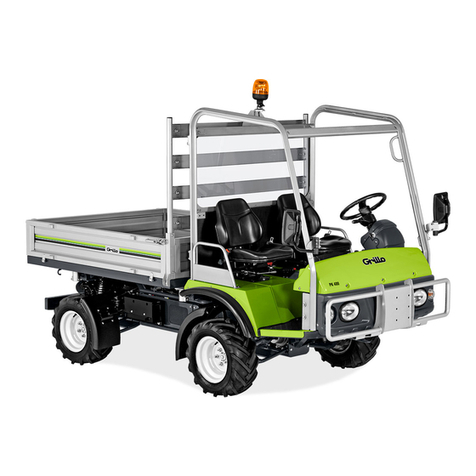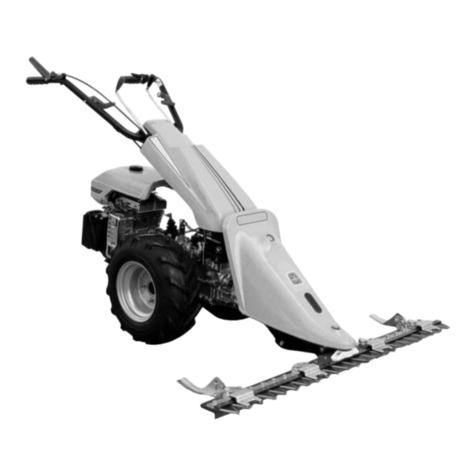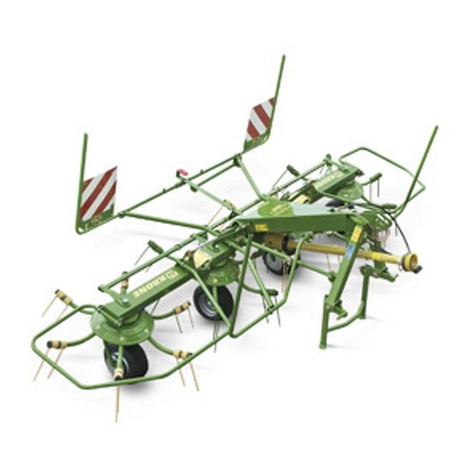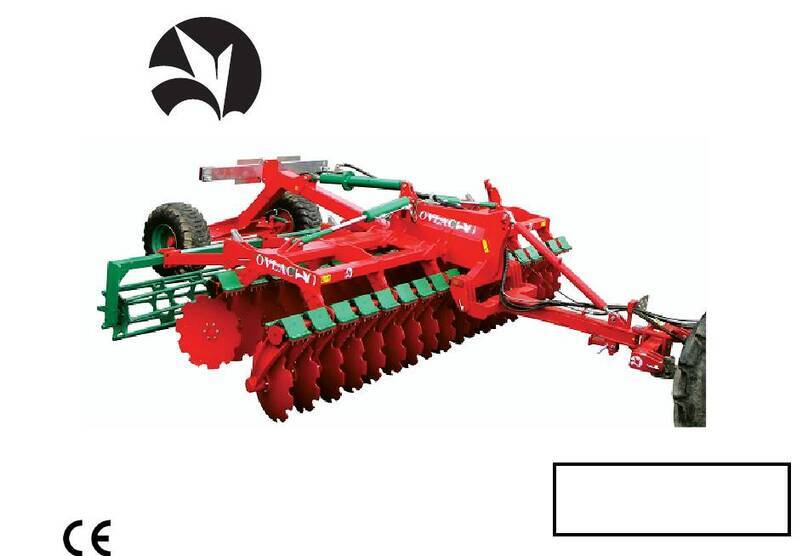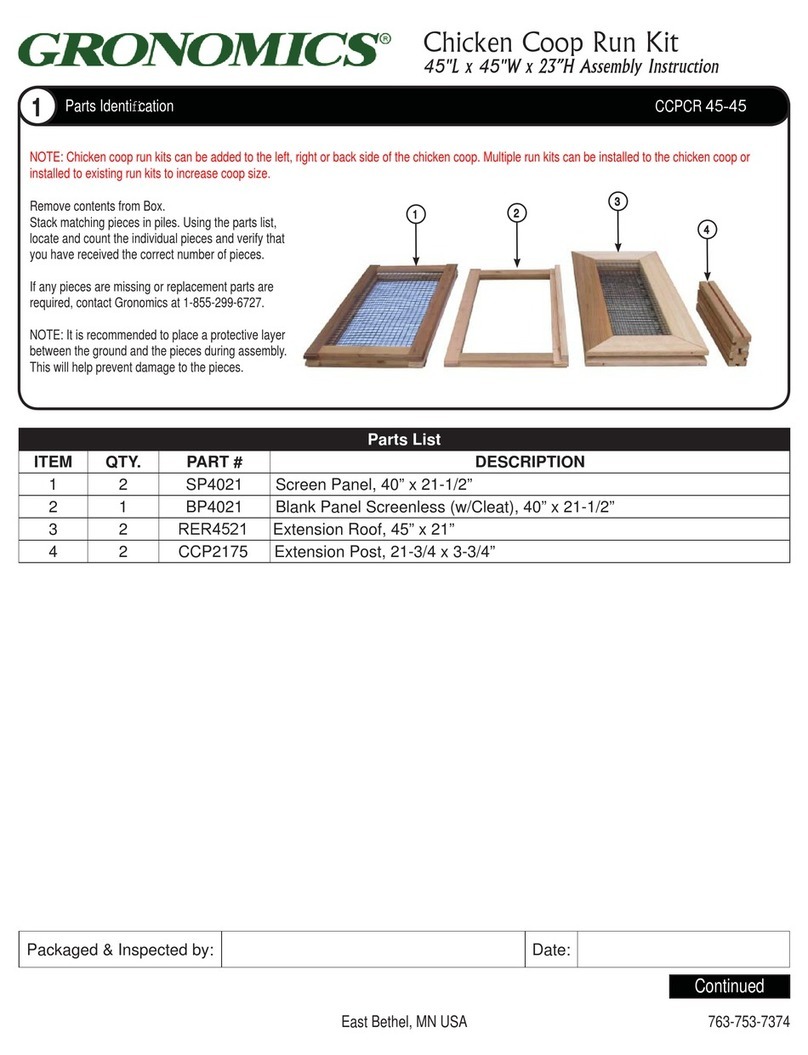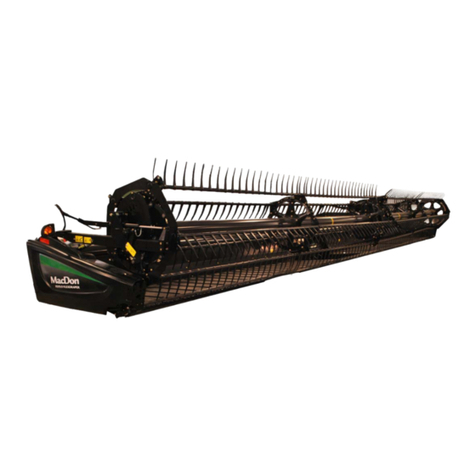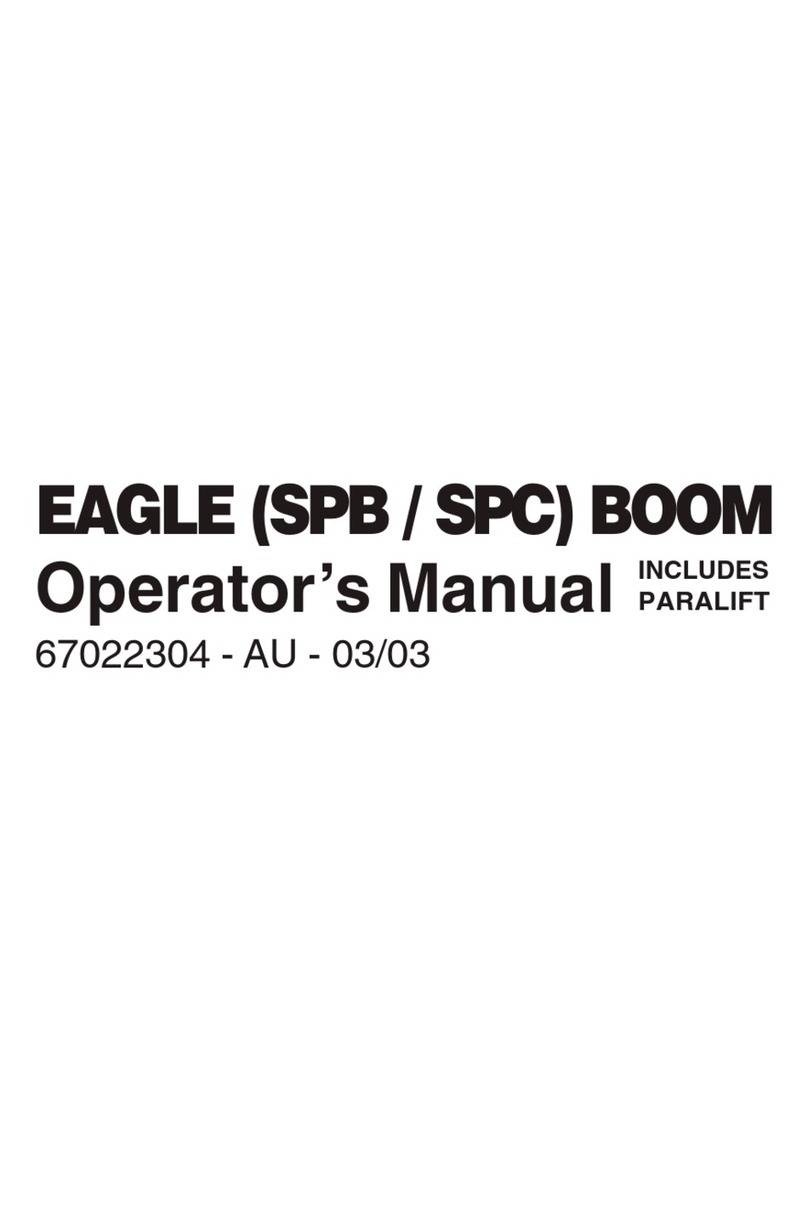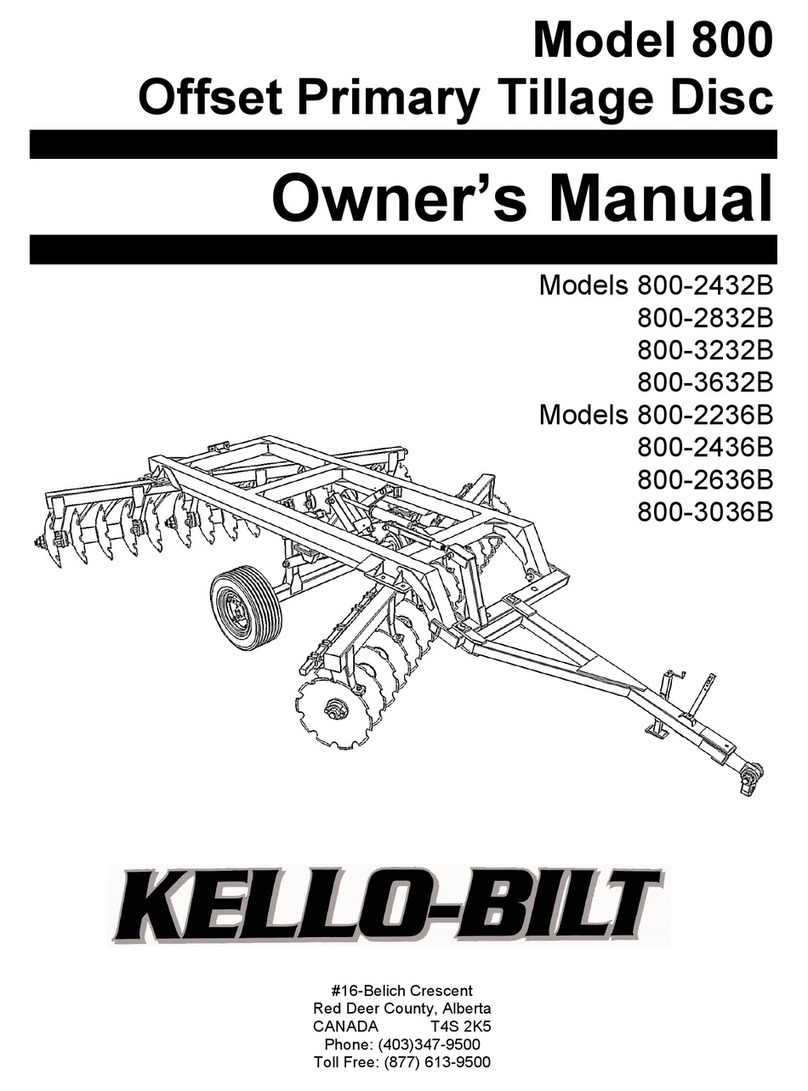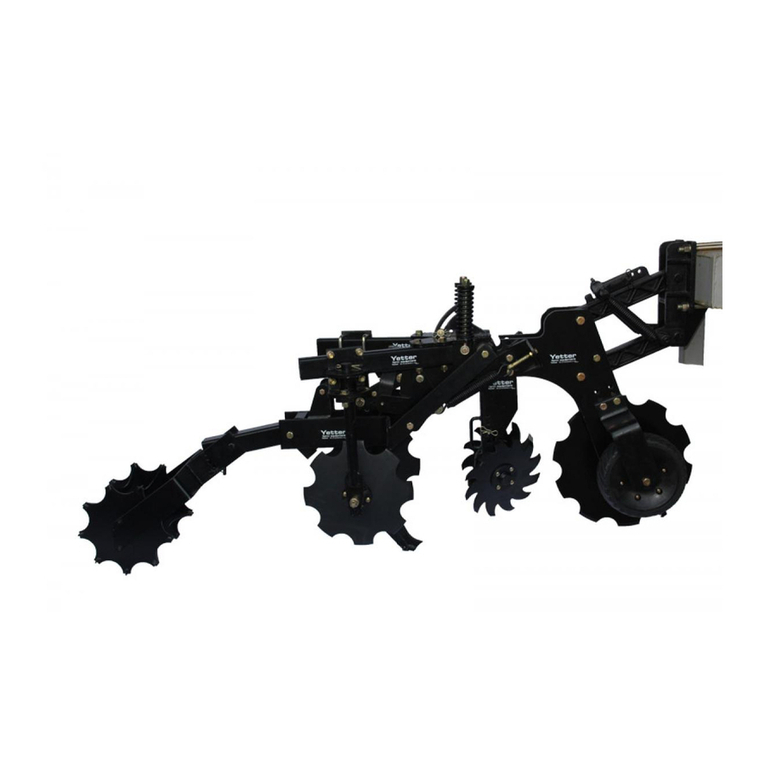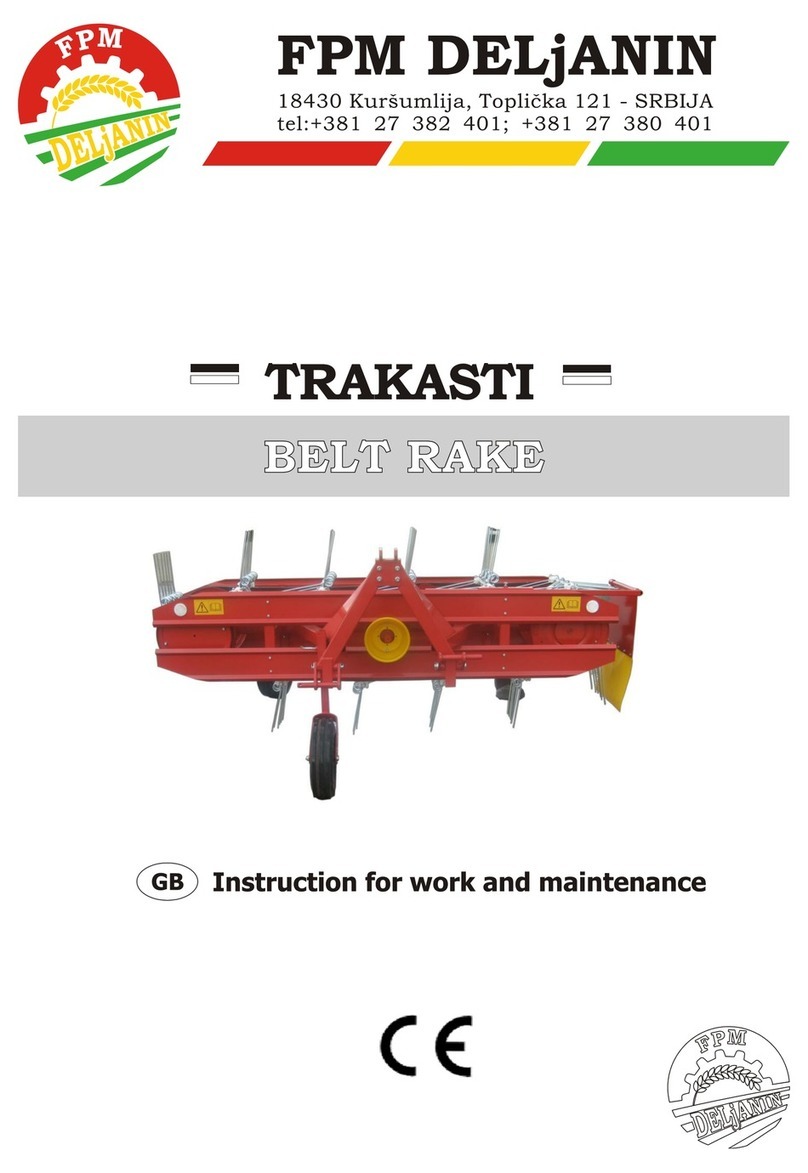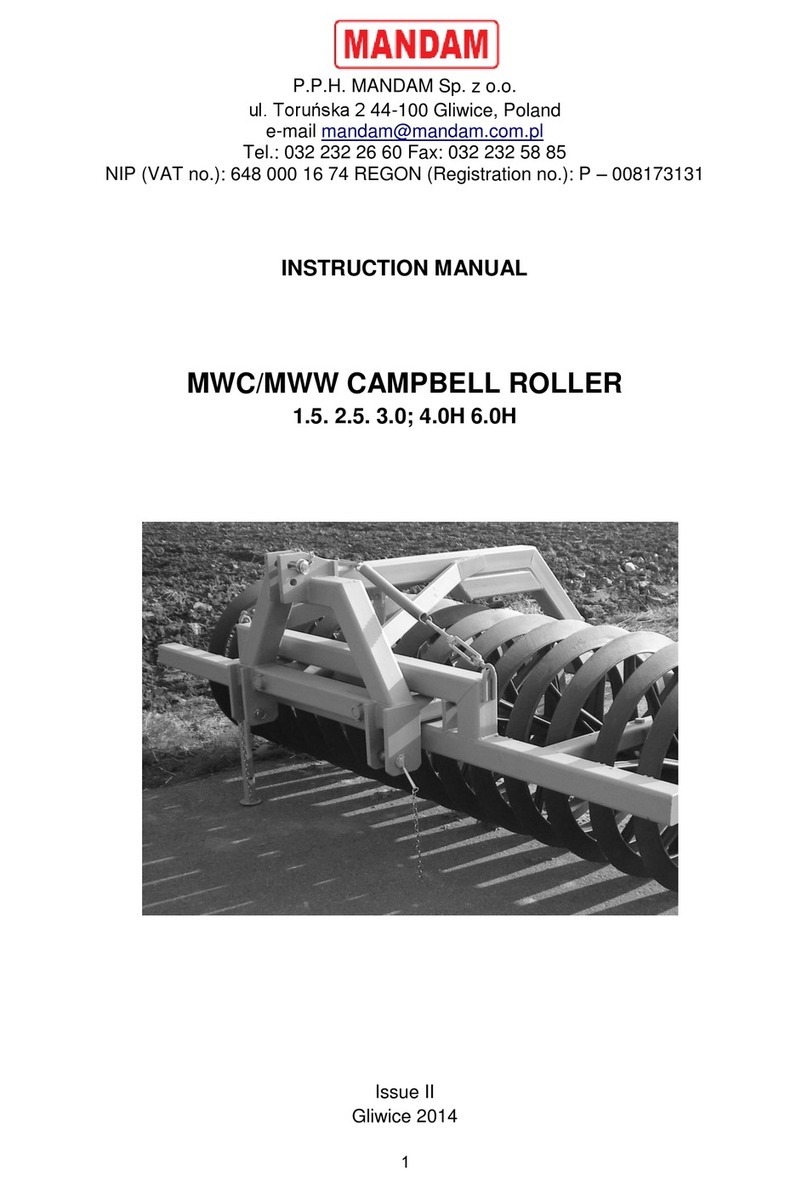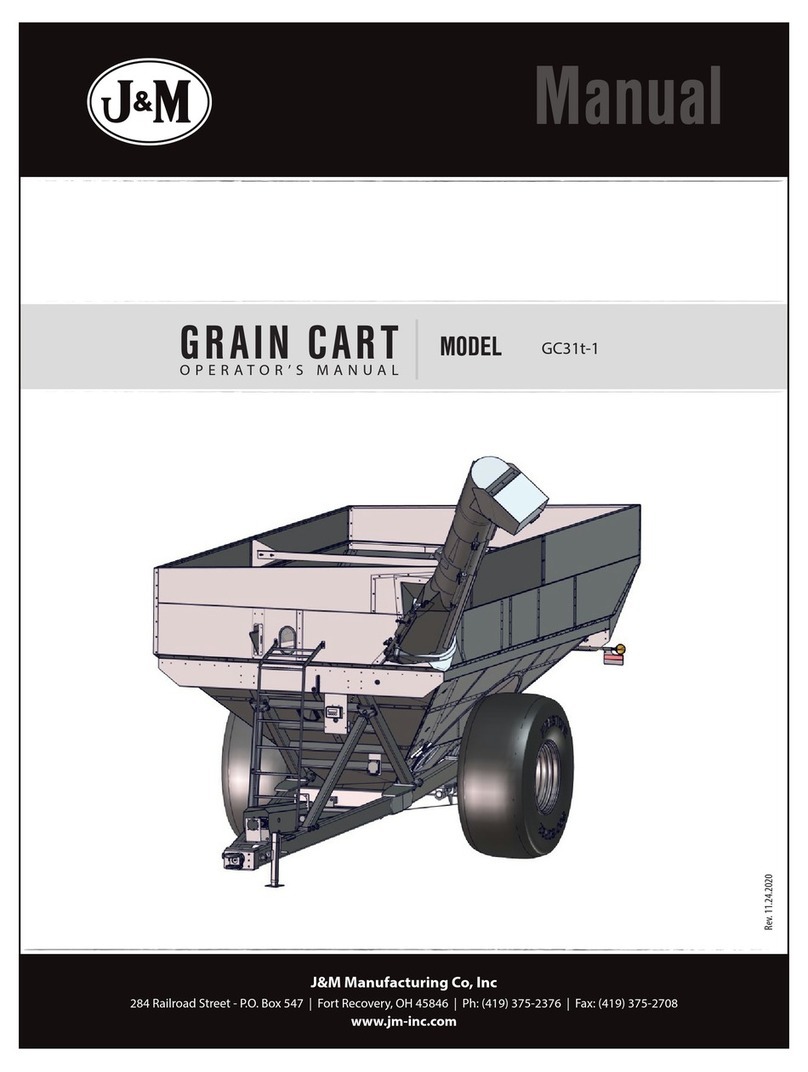Grillo DUMPER 406 User manual

GRILLO
DUMPER 406
OPERATOR'S MANUAL
MANUALE DELL'OPERATORE
MANUEL D'UTILISATION
BEDIENUNGSANLEITUNG
MANUAL DE INSTRUCCIONES
MANUAL DE INSTRUÇÕES
02289 - 21


SUMMARY
Safety rules
Instructions:
Warnings 5
Identification and servicing 6
Technical specifications 7
Putting the machine into service 7
Instructions for use 7
Maintenance and lubrication
Implements 11
Illustrations 40
EC Declaration of conformity - Noise and vibrations levels
INDICE
Norme antinfortunistiche
Istruzioni:
Avvertenze 12
Identificazione e assistenza 13
Caratteristiche tecniche 14
Messa in opera della macchina 14
Istruzioni d’uso 14
Manutenzione e lubrificazione 16
Accessori 18
Figure 40
Certificato di conformità CE - Rumorosità e livelli di vibrazione
INDEX
Règles de sécurité
Instructions:
Mises en garde 1
Identification et assistance 20
Caractéristiques techniques 21
Mise en service de la machine 21
Mode d’emploi 22
Maintenance et lubrification 23
Outils 25
Illustrations 40
Certificat de conformité CE - Niveaux sonores et de vibration
INHALTSÜBERSICHT
Sicherheitsvorschriften
Anleitung:
Sicherheitsrelevante Hinweise 26
Identifikation der Maschine und Kundendienst 27
Technische Daten 28
Inbetriebnahme der Maschine 28
Betriebsanleitung 28
Wartung und Schmierung 30
Zubehör 32
Abbildungsverzeichnis 40
EG-Konformitätserklärung - Geräuschemission und Vibrationspegel
ÍNDICE
Normas de seguridad
Instrucciones:
Advertencias 33
Identificación y asistencia 34
Características técnicas 35
Puesta en servicio de la máquina 35
Instrucciones de uso 35
Mantenimiento y lubricación 37
Equipos 3
Indice de ilustraciones 40
Certificado de conformidad CE - Niveles de ruido y vibración
- i -

SAFETY SYMBOLS - SIMBOLOGIA PER LA SICUREZZA - SYMBOLOGIE POUR LA SECURITE –
SICHERHEITSSYMBOLE- SIMBOLOGÍA DE SEGURIDAD
OPEN MANUAL- means that ou must read the operator's manual ver carefull .
MANUALE APERTO - significa che dovete leggere attentamente il manuale di uso e manutenzione.
MANUEL OUVERT – signifie qu'il faut lire avec attention le présent manuel.
OFFENES HANDBUCH – bedeutet, dass Sie die Gebrauchs- und Wartungsanleitung aufmerksam durchlesen müssen.
MANUAL ABIERTO – es decir que ha que leer mu atentamente el manual del operador.
CAUTION! - means that ou have to pa particular attention to the operation ou have to carr out, in particular if there is the
indication “DANGER”.
ATTENZIONE! - significa che dovete porre particolare attenzione all’operazione che dovete effettuare, in particolare se vi è anche
l’indicazione di “Pericolo”.
ATTENTION! - signifie qu'il faut faire particulière attention dans l'opération que vous allez faire, en particulier s'il a aussi
l'indication “DANGER”.
VORSICHT! - bedeutet, dass Sie besondere Aufmerksamkeit beim Durchführen des Vorgangs haben müssen, insbesondere wenn
auch der Hinweis “GEFAHR” aufgeführt ist.
ATENCIÓN! - es decir que ha que poner ma or atención en la operación a ejecutar si, en particular cuando ha también la
indicación “Peligro”.
INTERDICTION, YOU MUST NOT DO THAT! - means that it is absolutel forbidden to carr out the operations reported under this
s mbol because the could lead to mortal danger.
DIVIETO, NON FARE! - significa che non dovete assolutamente fare le operazioni riportate sotto questo simbolo, potrebbe
comportare un pericolo mortale.
INTERDICTION, NE PAS FAIRE! - signifie qu'il est absolument interdit d' effectuer les opérations reportées sous cette indication,
car elles pourraient conduire au danger de mort.
VERBOT, strengstens untersagt! - bedeutet, dass der Vorgang unter diesem S mbol absolut nicht durchgeführt werden darf, da er
zur einer lebensgefährlichen Situation führen könnte.
PROHIBICIÓN, NO LO HAGAN! - es decir que no ha que hacer absolutamente las operaciones bajo este símbolo, podría
comportar un peligro mortal.
NOTE, ou have to pa particular attention to the note put next to this s mbol
NOTA, dovete porre particolare attenzione alla nota posta accanto a questo simbolo.
NOTE, il faut faire attention particulière à la note mise à côté de ce s mbole.
ANMERKUNG, besondere Aufmerksamkeit muss auf die Anmerkungen neben diesem S mbol gelenkt werden.
NOTA, ha que poner atención particular en la nota puesta a lado de este símbolo.
You must not repair nor lubricate the machine with moving parts or with the engine put on.
Non riparare o lubrificare la macchina con organi in movimento o motore acceso
Ne pas réparer ou lubrifier la machine avec des parties en mouvement ou à moteur en marche.
Niemals bei bewegenden Objekten oder bei laufendem Motor Reparationen oder Einschmierungen durchführen.
No reparar ni lubrificar la máquina con órganos en movimiento o motor en marcha.
You must not smoke, light matches or lift flames, trigger frames nor cause sparks.
Vietato fumare, accendere fiammiferi o fiamme, lasciare fiamme libere o creare scintille.
Il est interdit de fumer, allumer des allumettes ou du feu, laisser des flammes libres ou de causer des étincelles.
Es ist untersagt zu Rauchen, Streichhölzer oder Feuer anzuzünden, Flammen auslösen oder Funken verursachen.
Prohibido fumar, encender cerillas o fuego, dejar llamas o crear chispas.
- 1
-
Use personal protective equipement
Utilizzare mezzi di protezione individuali
Utilisez l'équipement de protection individuelle
Individuelle Schutzausrüstung benutzen
Utilizar dispositivo de proteccion individual

GENERAL SECURITY RULES
NORME DI CARATTERE GENERALE SULLA SICUREZZA
SICHERHEITSHINWEISE
RÈGLES GÉNÉRALES DE SÉCURITÉ
NORMAS DE CARÁCTER GENERAL SOBRE LA SEGURIDAD
NORMAS DE CARÁCTER GENERAL ACERCA DA SEGURANÇA
Pay attention to symbol DANGER! It points out all most dangerous operations according to the situation. All safety rules are important and therefore must be strictly
observed. Always keep this handbook within the reach, read it carefully and learn how to use the equipment in a safe way. Let nobody, not provided with necessary
information, work with the equipment.
Fare attenzione al simbolo PERICOLO! Esso indica la presenza delle principali situazioni di pericolo. Tutte le norme antinfortunistiche contente sono importanti e
vanno rispettate. Tenere sempre questo manuale a portata di mano, leggerlo attentamente ed imparare ad usare l’attrezzatura in modo sicuro. Non permettere che
qualcuno operi con questa attrezzatura senza aver ricevuto istruzioni esaurienti.
Attention au symbole DANGER! Il indique la pr sence des principales situations de danger. Toutes les normes contenues pour la pr vention des accidents sont
importantes et doivent être respect es scrupuleusement. Garder toujours ce manuel à la port e de la main, le lire attentivement et apprendre à utiliser ce mat riel
en toute s curit . Ne pas permettre que d’autres personnes utilisent ce mat riel sans avoir reçus des instructions exhaustives.
Achtung - die mit dem ymbol GEFAHR! gekennzeichneten Hinweise weisen auf potentielle Gefahrensituationen hin. Alle sicherheitsrelevanten Hinweise in
diesem Handbuch sind sehr wichtig und müssen unbedingt befolgt werden. Bewahren ie dieses Handbuch stets griffbereit auf, lesen ie es aufmerksam durch,
und lernen ie, die Maschine und die gesamte Ausrüstung sicher zu benutzen. Die Maschine darf nur von Personen benutzt werden, die vorher entsprechend
unterwiesen wurden.
Preste atención al símbolo ¡PELIGRO! Indica la presencia de situaciones importantes de peligro. Todas las normas de prevención de accidentes detalladas son
importantes y deben respetarse estrictamente. Conserve este manual al alcance de la mano, l alo atentamente y aprenda a utilizar el equipamiento de modo
seguro. No permita que otras personas operen con este equipamiento sin haber recibido instrucciones exhaustivas.
Take special care not to touch hot parts of the engine.
Prestate particolare attenzione a non entrare in contatto con parti surriscaldate
del motore.
Veiller tout particulièrement à ne pas toucher des l ments surchauff s du
moteur.
Achtung – keine heißen Motorteile berühren!
No tocar partes recalentadas del motor.
Tome muito cuidado para não entrar em contacto com as partes aquecidas do
motor.
Engine exhaust fumes can cause sickness or death. If it is necessary to run an
engine in an enclosed area, use an exhaust pipe extension to remove the
fumes. Always try to work in a well ventilated area.
I gas di scarico possono causare malanni o morte. Se è necessario mettere in
moto un motore in uno spazio chiuso, usare una prolunga tubo di scarico per far
uscire il fumo. Lavorare in una zona ben ventilata.
L’exhalation des gaz d’ chappement peut être cause d’intoxication ou de mort.
S’il est vraiment n cessaire d’allumer le moteur à l’int rieur, appliquer au tuyau
d’ chappement un autre tuyau extensible pour permettre la sortie des gaz. Il est
toujours mieux de travailler en plein air.
Auspuffgase können Übelkeit oder Tod verursachen. Wenn es notwendig ist,
einen Motor in einem geschlossenen Raum laufen zu lassen, benützen Sie eine
Verlängerung, um das Auspuffgas abzuleiten. Versuchen Sie immer in einem
gut belüfteten Raum zu arbeiten.
Los gases de escape pueden provocar enfermedades o muerte. De tener que
poner en marcha un motor en un espacio cerrado, usar una prolongación del
tubo de escape para que salga el humo. Trabajar en una zona bien ventilada.
Os gases de escape podem causar danos ou morte. Caso seja necessário
fazer com que o motor funcione num espaço fechado, utilize uma extensão
para o tubo de escape que os fumos sejam expulso para o exterior. Trabalhe
numa área bem ventilada.
Handle fuel with care, it is highly flammable: Do not refuel machine while
smoking, when machine is near an open flame or sparks, or when the engine is
running. Stop the engine.
Maneggiare il carburante con cura, è altamente infiammabile; non fate
rifornimento mentre fumate, o vicino a fiamme o scintille, o quando il motore è
acceso.
Manier avec soin le carburant car c’est très inflammable. Ne pas remplir le
r servoir si vous êtes en train de fumer ou pendant que la machine est près du
feu ou d’ tincelles ou encore pendant que la machine travaille. Arrêter le
moteur.
Treibstoff vorsichtig handhaben, da er sehr entzündbar ist: beim Tanken nicht
rauchen. Nicht tanken, wenn die Maschine in der Nähe von Flammen oder
Funken ist oder wenn der Motor läuft. Immer den Motor abschalten.
Manejar el combustible con cuidado porque es sumamente inflamable; no
repostar mientras se fuma o cerca de llamas o chispas, o cuando el motor está
encendido.
Manuseie o carburante com cuidado, pois este è altamente inflamável; não
fume durante o abastecimento da máquina ou enquanto o motor estiver ligado,
não o aproximado de chama ou de faíscas.
- 2
-

WARNING! SHARP PARTS. Keep hands and feet away. Do not operate the
mower over gravel or foreign bodies which may be sucked up and ejected by
the blades, generating a danger. Keep people away. Remove the key and read
the instruction manual before attempting to carry out any maintenance or
repairs to the machine.
ATTENZIONE! ORGANO TAGLIENTE. Tenere lontano mani e piedi. Non
lavorare col rasaerba sopra alla ghiaia o corpi estranei che possono essere
aspirati e centrifugati dalle lame risultando molto pericolosi, tenere lontano le
persone. Togliere la chiave e leggere le istruzioni prima di effettuare qualsiasi
operazione di manutenzione e riparazione.
ATTENTION! ORGANE TRANCHANT. Éloigner les mains et les pieds. Ne pas
utiliser la tondeuse sur le gravier ou sur des corps qui peuvent être aspir s et
centrifug s par les lames et devenir très dangereux. Les personnes doivent se
trouver à une certaine distance. Enlever la cl et lire les instructions avant toute
op ration de maintenance et de r paration.
ACHTUNG! SCHARFE KLINGEN. Hände und Füße fernhalten. Beim Mähen
nicht über Schotter, Steine oder andere Fremdkörper fahren, da diese durch die
Drehbewegung der Messer angesaugt und weggeschleudert werden können
(Verletzungsgefahr). Nicht in der Nähe von anderen Personen mähen. Vor
jedem Wartungs- bzw. Reparatureingriff den Startschlüssel abziehen und die
Gebrauchsanleitung durchlesen.
¡PELIGRO! ÓRGANO CORTANTE. Mantener alejados los pies y las manos.
No limpiar la herramienta con el motor en marcha. ¡Peligro! Expulsión de
objetos: mantener alejadas a las personas. Atención: quitar la llave y leer las
instrucciones antes de efectuar cualquier operación de mantenimiento o
reparación.
ATENÇÃO! Órgão cortante. Ficar longe com p s e mãos. Não trabalhar com a
máquina sobre cascalho ou objetos que podem ser aspirados e centrifugados
gerando perigo, manter-se longe das pessoas.
Tirar a chave de ignição e ler as instruções antes de efetuar qualquer operação
de reparo ou serviço.
Warning! Cutting edges, keep your hands and feet away.
Do not clean the attachment when the engine is running.
Attenzione! Organo tagliente, tenere lontano piedi e mani.
Non pulire l'attrezzo col motore in moto.
Attention! Organe tranchant, ne pas approcher main et pieds.
Ne pas nettoyer le moteur quand le moteur est en marche.
Achtung! Schneidende Klinge, Hände und Füße fernhalten.
Niemals bei laufendem Motor reinigen.
DANGER! READ THE INSTRUCTION MANUAL. KEEP SAFETY DISTANCES.
PERICOLO! LEGGERE IL MANUALE D’ISTRUZIONE. TENERE LONTANO LE
PERSONE.
DANGER! LIRE LE MANUEL D’INSTRUCTIONS. RESPECTER LES
DISTANCES DE SÉCURITÉ
GEFAHR! DIE GEBRAUCHS ANLEITUNG DURCHLESEN. NICHT IN DER
NÄHE VON ANDEREN PERSONEN MÄHEN.
PELIGRO! LEER LAS INSTRUCCIONES. MANTENER ALEJADAS LAS
PERSONAS.
PERIGO! LER O MANUAL DE INSTRUÇÕES. MANTER AS PESSOAS
AFASTADAS.
Before using the machine, it is mandatory to put on the appropriate individual
safety devices: body protection, protection gloves, security shoes, ear
protection.
Prima di utilizzare la macchina, è obbligatorio indossare gli appositi dispositivi di
sicurezza individuali: protezione del corpo, guanti di protezione, calzature di
sicurezza, protezione dell’udito.
Avant d’utiliser la machine, il est obligatoire de mettre les dispositifs individuels
de s curit appropri s: protection du corps, gants de protection, chaussures de
s curit , protection de l’ouïe.
Vor dem Gebrauch der Maschine ist es vorgeschrieben, die geeignete
persönlichen Schutzkleidung anzuziehen: Körperschutz, Schutzhandschuhe,
Sicherheitsschuhe, Gehörschutz.
Antes de utilizar la máquina es obligatorio ponerse los dispositivos individuales
de seguridad apropiados: protección del cuerpo, guantes de protección,
calzado de seguridad, protección del oído.
- 3
-

Translation of the original instructions
TRACKED CARRIER
D406
Dear Customer,
Thank you for choosing our Dumper 406, we are sure that your new machine’s performance will meet your requirements
in full. To ensure optimum service an maintenance of its qualities over time, rea this manual carefully an follow its
instructions. This will give you the best results an protect your investment. Please keep this manual, which must always
accompany the machine.
GENERAL DESCRIPTION AND INTENDED USE
Our Dumper 406 is a tracke carrier with loa ing bo y esigne for the transport of materials on slippery an ownhill
groun s.
CAUTION! Before starting t e engine, read t is carefully. T e following warnings are
very important in ensuring safety!
WARNINGS
Caution is the main safeguar in preventing acci ents. We urge you to rea the warnings that follow when using the
tracke carrier, before starting any work at all. Improper use of the tracke carrier an its equipment can be angerous.
To re uce the risks to the minimum, observe the necessary precautions set out below:
1) Rea the whole of this manual before using your tracke carrier. Be thoroughly familiar with the controls an the
proper use of the machine before starting.
2) Pay special attention to the safety warnings an labels.
3) The rotating tiller is extremely angerous; o not touch the tracks, the car an joint or other accessories (such as flail
mower an snow thrower) when the machine is on.
4) Before other people are allowe to use the machine, make sure they are informe about the safety regulations an
how to properly use this equipment.
5) Ensure chil ren an animals are kept at a safe istance of about 15 metres. Do not allow people to come closer to the
tracke carrier when it is being use .
6) Do not use the machine when physically fatigues or un er the influence of alcohol or rugs that coul impair the
operator's physical an mental capacities.
7) Thoroughly check the groun before using the tracke carrier an remove any object that coul amage the tines (e.g.
stones) or that coul be caught up an flung own, therefore becoming highly angerous. (e.g. branches, stones).
8) Always wear suitable clot ing and footwear. It is recommended to wear safety footwear, safety goggles, ear
plugs and gloves, long trousers. Do not wear clot ing or accessories t at could get trapped in t e controls or in
t e tiller (e.g. loose trousers, scarves…).
9) Pay close attention when working on slopes. Always work across the slope an never upwar s/ ownwar s. Pay
greater attention when changing irection on slopes an never work on excessively steep groun .
10) Never allow the machine to be use by anyone un er 16 years of age.
11) Pay close attention when operating the machine in reverse, make sure that there are no obstacles behin you. In
case of anger release the han lebar an the machine will stop imme iately.
12) It is angerous to sharply activate the levers with the engine at maximum r.p.m.
13) Do not operate the engine in a confine space where angerous carbon monoxi e fumes can collect.
14) CAUTION: Petrol is ig ly inflammable. Store fuel in containers especially esigne for this purpose. Refuel
out oors an away from any open flames or sparks. Never smoke when refuelling. Stop the engine before refuelling an
never refuel with the engine running. Never remove the tap of the fuel tank or a fuel when the engine is hot. If fuel is
spille , o not attempt to start the engine but move the machine away from the area of spillage an avoi creating any
source of ignition until fuel vapours have issipate . After refuelling all fuel caps shoul be close securely.
15) Avoi spillages an clean up all spills straight away.
16) Store fuel in containers especially esigne for this purpose.
17) Make sure you work preferably in natural light or goo artificial light.
18) Never use the tracke carrier to crush buil ing, metallic an plastic material nor roots an trunks or any sort of
garbage.
19) Do not use the machine to transport people, animals or objects.
20) Never disable safety devices.
21) Always stop t e engine before making any adjustment or cleaning.
22) Never allow anyone to c eck t e mac ine wit engine running.
23) The user is always responsible for injuries or amages cause to thir parties an for any risk they coul run.
24) Damage tines must always be replace an never repaire .
25) Always use genuine Grillo spare parts.
26) Before starting any work with the machine, check that all the acci ent prevention systems with which it is equippe
with are in perfect working or er. They must never be isable or tampere with.
27) Before starting work, c eck t at t e nuts and bolts securing t e load body and t e accessories are perfectly
secured.
28) Never operate the machine without safety protective evices in place (such as mu guar s an engine bonnets).
29) Never clean t e mac ine wit t e engine running.
30) Never use t e mac ine barefoot.
31) Never change the max RPM engine settings nor any other engine settings.
5

Translation of the original instructions
32) Allow t e engine to cool before storing in any enclosure.33) CAUTION: To re uce the risk of fire, keep the
engine, the exhaust pipe an the exhaust manifol s free from grass, leaves, ust, etc…
34) Drain the fuel only out oors.
35) Do not run with the tracke carrier.
36) Pay particular attention when tilting the loa bo y, DANGER OF CRUSHING!
37) Do not lift or transport the machine with the engine running.
38) Do not store t e mac ine wit fuel in t e tank w ere petrol vapours could reac an open flame or source of
ignition.
39) Grillo tracke carriers has been esigne with the sole purpose of being use with original Grillo attachments of with
attachments esigne by other manufacturers expressively authorize by Grillo. Non original attachments as well as
attachments pro uce an /or mo ifie by non-authorize manufacturers must never been connecte to the tracke
carrier. If you have any question or oubt please contact the nearest Grillo authorize ealer.
Any improper use will void t e warranty and t e manufacturer will not be eld responsible for any damage t at
occurs t ereafter.
CAUTION!
We recommen the use of ear plugs/protection shoul the tracke carrier be use for a prolonge time. Use acoustic
protections compliant with the current law (see picture below).
IDENTIFICATION AND SERVICING
IDENTIFICATION
The vehicle’s serial number is on the nameplate locate
on the machine's the chassis.
AFTER-SALES SERVICE
This han book provi es instructions for use of the machine an for correct basic servicing which the user can carry out
himself. For all proce ures not escribe in this han book, contact your local ealer.
SPARE PARTS
Always use original spare parts, as they are the only ones to offer complete safety an interchangeability. Always state
the serial number when or ering. For engine parts, refer to the specific han book.
GUARANTEE
The guarantee is given in compliance with the current law. The ealer will have to give the client a copy of the
registration car of the machine, which they will print up from the Grillo website. For the engine the guarantee of the
relative manufacturers apply.
SERIAL NO.
-------------------
PURCHASE DATE
-------------------
GRILLO AUTHORIZED DEALER
-------------------
6

Translation of the original instructions
ORDERING SPARE PARTS
Always state the machine serial number an the co e number of the part to be replace .
Contact your local ealer. Our a ress is:
GRILLO S.p.A.
Via Cervese 1701 - 47521 CESENA (FC) - ITALY
Tel. 0039 / 0547 / 633111 - Fax 0039 / 0547 / 632011
Web site: www.grillospa.it - E-mail: [email protected]
TECHNICAL SPECIFICATIONS
ENGINES:
– HONDA GX200 196 cc, 5,5 HP (@ 3600 r.p.m.) 4-stroke one cylin er petrol engine.
– KOHLER 3000 196 cc, 5,5 HP (@ 3600 r.p.m.), 4-stroke one cylin er petrol engine.
STARTER: with recoil starter.
FUEL TANK: 3,6 litres.
CLUTCH: per belt tension.
GEARBOX: gears in oil bath with 6 spee s: 3 forwar spee s + 3 reverse spee s.
SPEED: I km/h 1 - II km/h 2 - III km/h 3.5 – I-R km/h 1 – II R km/h 2 – III R km/h 3.5.
DRIVE: rubber tracks with inner steel links.
STEERING: with clutches in oil bath combine with brakes.
LOAD BED: 1000×655×200 mm (height 33 cm with top extension si es). With si e ump boar s through gas spring.
OVERALL HEIGHT WITH LOAD BED: 43,5 cm.
LOAD CAPACITY: 400 kg.
SECURITY DEVICES: automatic han brake.
TRACK BEARING SURFACE: 70 cm.
TRACK EXTERNAL BULK: 65 cm.
WEIGHT: 267 kg (with Kohler 3000) - 268 kg (with GX200)
PUTTING THE MACHINE INTO SERVICE
1) Check that the machine has not been amage uring transport.
2) Check the engine oil level.
3) Fill the tank with fuel using a funnel with a very fine filter.
4) All checks have to be carrie out with the machine in horizontal position.
5) Check the tension of the tracks (fig. 6). If necessary increase their tension by loosening the counter-nut an then
fastening the bolt.
6) Check that the steering levers are working properly.
7) Check that the loa bo y is firmly secure .
INSTRUCTIONS FOR USE
STARTING THE ENGINE
After making the checks escribe :
Bring the han throttle lever (4, fig. 1) to the mi way position an engage the choke (10, fig. 1). Start the engine by
pulling the pull-start knob sharply (9, fig. 1).
After the engine has starte , isengage the choke (10, fig. 1) an gra ually return the throttle close to the i ling
position.
Allow the engine to warm up for a few minutes before starting work, an to allow proper running-in o not force the
machine excessively uring the first 50 hours of use.
STARTING THE PETROL ENGINE
1) Open the fuel tap (fig. 10, n. 1)
2) Push throttle lever halfway (fig. 1, n. 4)
3) Engage the choke evice if the engine is col (fig. 1, n. 2).
Engine with recoil starter:
- Make sure the button place on the engine is in “ON” position (fig. 11, n. 1)
- Start the engine by strongly pulling the knob (fig. 10, n. 3).
7

Translation of the original instructions
STARTING THE MACHINE
Engage the chosen gear via the appropriate lever place left on the ashboar (fig. 1, no. 2). The machine will start
moving when lowering the clutch lever (fig. 7, pos. A). CAUTION: before pulling t e clutc lever to move t e
mac ine, always c eck w ic gear is engaged. If the gear oes not engage imme iately, give light touches on the
clutch. When releasing the clutch lever (fig. 7, B) the machine will stop moving but the engine keeps on running.
IN CASE OF DANGER IMMEDIATELY RELEASE THE CLUTCH LEVER (fig. 8, D), THE MACHINE WILL
IMMEDIATELY STOP.
STEERING THE MACHINE
To turn right pull the right lever (fig. 1), to turn left pull the left lever (fig. 1).
To stop turning the machine release the lever 5 (fig. 1) an the machine will keep on moving straight forwar .
IN CASE OF DANGER IMMEDIATELY RELEASE THE CLUTCH LEVER (fig. 8, D), BOTH MACHINE AND IMPLEMENT
WILL IMMEDIATELY STOP.
REVERSE GEAR
To engage the reverse gear use the lever place right on the ashboar (fig. 1, n. 3). If the reverse gear oes not
engage imme iately, give light touches on the clutch. When riving in reverse pay close attention to the groun behin .
IN CASE OF DANGER IMMEDIATELY RELEASE THE CLUTCH LEVER (fig. 7, B), THE MACHINE WILL IMMEDIATELY
STOP
TILTING THE LOAD BODY
The loa bo y can be tilte with the engine on an with the engine off.
Pull the lever to unlock the loa bo y tilting (fig. 1, no. 6), then raise the loa bo y using the appropriate lever. To bring
the loa bo y back into horizontal position pull the lever until the safety hook is locke .
CAUTION: DANGER OF CRUSHING! PAY PARTICULAR ATTENTION WHEN RAISING AND LOWERING THE LOAD
BODY.
IMPORTANT: DO NOT RAISE NOR LOWER THE LOAD BODY WHEN THE MACHINE IS MOVING.
SWITCHING OFF THE PETROL ENGINE
For the machine with recoil starter:
- turn the switch place on the engine into position “OFF” (fig. 11, n. 1)
END OF WORK
Switch off the engine an engage the i le position once work is one.
CAUTION: never leave the machine unguar e or in a place where chil ren or inexperience people coul have easy access to
it.
TIPS FOR EFFICIENT USE
1) Never leave the machine expose to ba weather con ition.
2) Never force the gear: If the gear oes not engage imme iately, give light touches on the clutch until it engages.
3) Never strain t e engine: if smoke comes out of t e ex aust, slow down.
TROUBLESHOOTING
The following is a list of inconveniences which may occur uring the use of the tracke carrier, which the operator himself
can reme y.
1) if the petrol engine oes not start check:
– that the fuel tank is at least half full;
– that the petrol cock is turne on;
– that the choke is engage (when the engine is col );
– that fuel is normally going to the carburettor;
– that the vent hole on the fuel tank is not blocke ;
– that the mesh filter at the carburettor intake is clean;
– that the carburettor jets are clean. Check by unscrewing them an if irty, clean them with a jet of air;
– that spark plug is generating a spark. To check this, remove the spark plug, re-connect it to the electricity supply wire,
rest the metal si e on an electrical earth an turn the engine-pulley as if to start it. If no spark is seen between the
electro es, check the connection of the spark plug cable; if there is still no current replace the spark plug with a new one.
If a spark is still not obtaine , the problem is in the electric system: capacitor, coil, or in some other component. Contact
your nearest service centre or a specialist workshop.
IN CASE OF LONG IDLE PERIODS
Shoul the machine not be use for a long time:
- fully empty the fuel tank.
- thoroughly clean both the engine an the tracke carrier.
8

Translation of the original instructions
MAINTENANCE AND LUBRICATION
CAUTION!
- Disconnect t e plug before performing any cleaning, maintenance or repair operation. Always wear suitable
clot ing and working gloves.
- W en t e mac ine or part of it is lifted to carry out maintenance operations, always remember to use suitable
fixing tools suc as olders and safety locks.
- W en carrying out maintenance operations and/or w en t e mac ine is tilted wit out safety locks or supports,
never leave it unguarded in places w ere inexperienced people and c ildren could ave easy access to it.
- Protect t e environment: carefully dispose of used oils, petrol and any ot er pollutant product!
- Effective maintenance and correct lubrication elp to keep t e mac ine fully efficient.
Note: all checks have to be carrie out with the machine in horizontal position.
ENGINE OIL
Follow the instructions on lubrication intervals in the relative manual. In general users are a vise to check the oil level
every 4 working hours an replace it every 100 hours (fig. 9, n. 1).
GEARBOX OIL
Check the level every 50 working hours an a 85W90 oil if necessary. Replace the oil once a year (quantity 1,350 kg)
by loosening the screw (fig. 8).
ENGINE AIR FILTER
Check the filter every 8 working hours. For engines equippe with a ry air filter replace the cartri ge when it is too
clogge ( o not use compresse air to clean it). For engines equippe with oil-bath filter, a or replace oil. Use the
same oil as for the engine.
TRACK ROLLERS
- Frequently grease the track roller pins (fig. 6)
- Frequently check the track roller tension
The truck capacity is 400 kg, but users are a vise to consi er the terrain on which the vehicle is to be use when
eci ing the loa which can be transporte . Remember that since this is a tracke carrier vehicle, it pitches consi erably
on humps, curbs an steps. When crossing such obstacles, use low gears an take special care; engage a low gear an
retain it until back on level groun . If the machine is stoppe on steep slopes, when releasing the lever (fig. 7, pos. B) the
parking brake is automatically engage . Although the truck has rubber tracks, remember to take care in ifficult
environmental con itions (ice, heavy rain or snow) or on terrains which might make the vehicle unstable.
RUBBER CRAWLER TRACKS – PRECAUTIONS FOR USE
1) TRACK TENSION
1) When the machine is lifte off the groun , the rubber tracks must sag by 10-15 mm as shown in the iagram.
10-15 mm
Fig. 10- Rubber crawler tension
2) When the track becomes slack, it must be a juste to prevent the machine via the a justing screw (fig. 6).
2) PRECAUTIONS WHEN DRIVING
1- Avoi jerky operations when the crawler truck is in motion.
2- Keep the rubber crawler track away from sharp e ges of concrete etc.
3- Cracks on the outsi e surface of the rubber track (in contact with the groun ) are very often ue to contact with
gravel, sharp stones an sharp materials such as sheet metal, nails an glass.
3) AVOID SUDDEN CHANGES IN DIRECTION
Sharp turns on concrete surfaces or excessive accelerations which generate high friction coefficients
must be avoi e since they might cause cuts in the rubber.
4) AVOID CONTAMINATION WITH OIL
Fuels an hy raulic flui s must never come into contact with the rubber crawler track. If this shoul
occur, clean imme iately.
9

Translation of the original instructions
5) REPLACING THE SPROCKET
If abrasions an wear are note on the sprocket, it must be replace as soon as possible since in these con itions it
might cause abrasion or reveal the metal core.
6) OPERATING TEMPERATURE
The i eal operating temperature for the rubber crawler track is between -25° an 55° C, because of the fun amental
properties of the rubber.
ADJUSTMENT OF THE STEERING LEVERS
When pulling the steering lever to turn right (fig. 1, n. 5) the right hammer insi e the gearbox (fig. 12) lock the hole of the
crown gear an block the track traction. In the meantime the right track brake will be engage . When the lever is
release the hammer gets out of the crown gear, the brake is unlocke an the machine goes forwar again.
Shoul the machine not turn properly or shoul the lever not come back to its original position once release , a just the
self-locking nut place on the hammer ro (fig. 12) an on the brake ro (fig. 14).
When the steering lever is not engage (fig. 1, n. 5) the hammer shoul not lock the gear crown (fig. 12) an the brake
must not be blocke (fig. 14).
AUTOMATIC SAFETY BRAKE
Please note this a justment must be carrie out by an authorize ealer. To a just the brake use the a justing screw
(fig. 16, pos. B). The machine must hol firmly even at full loa an on a slope.
TRACTION BELT TIGHTENER
Check that the belt tightener has sufficient freeplay to avoi pulling the belt into stop position. During work the belt
tightener retrun spring must be tensione (fig. 15). CAUTION: THE ROTATION OF BOTH THE BELT AND THE
PULLEYS IS HIGHLY DANGEROUS, THIS CHECK MUST BE ABSOLUTELY CARRIED OUT WHEN THE ENGINE IS
OFF.
MAINTENANCE SUMMARY TABLE
PROCEDURE EVERY 8 HOURS AFTER 20
HOURS
EVERY 50
HOURS
EVERY 100
HOURS
EVERY 200
HOURS
Engine oil check the level ●
change ● ●
Air filter
check ●
replace ٭
Spark plug check/a just ●
replace ●
Gearbox oil Check the level ● ●
replace ●
Check that the engine intake gri is clean
●
● recommen e proce ure
٭ procedure to be carried out if necessary
10

Translation of the original instructions
EXTENDIBLE LOAD BODY (fig. 2)
The wi th of the si e boar s can be a juste to increase or ecrease the loa bo y overall imensions an its loa ing
capacity:
- INTERNAL SIZE with close bo y: 100 cm x 70 cm, H 40 cm
- INTERNAL SIZE with fully open bo y: 118 cm x 122 cm, H 40 cm
- EXTERNAL SIZE with close bo y: 105 cm x 75 cm
- EXTERNAL SIZE with fully open bo y: 123 cm x 127 cm
WEIGHT: 74 kg
MAX. LOAD CAPACITY: 400 kg
WARNINGS FOR TRANSPORT
Tracke carriers cannot be use on public roa s. If the machine is to be transporte on a lorry or a trailer, make sure it
safely fastene to the lorry/trailer via ropes an /or belts. If a lifting machine is use to lift the tracke carriers from the
groun into the lorry/trailer make sure its lifting capacity its suitable for the machine.
11

Original Instructions - Istruzioni Originali - Instructions Originales - Original Anleitungen - Instrucciones Originales – Instruções Original
MOTOCARRIOLA CINGOLATA
DUMPER 406
Gentile Cliente,
nel ringraziarLa per la fiducia e la preferenza accordata alla nostra motocarriola, confidiamo che l'uso di uesta sua
nuova macchina risponda pienamente alle sue esigenze. Per l'impiego ottimale e per la sua manutenzione nel tempo, la
preghiamo di leggere attentamente e seguire scrupolosamente le indicazioni di uesto libretto; ciò le consentirà di
ottenere i massimi risultati e salvaguardare la sua spesa. La preghiamo di conservare uesto libretto, che dovrà sempre
accompagnare la macchina.
DESCRIZIONE GENERALE ED USO PREVISTO
Il Dumper 406 è una motocarriola cingolata con cassone di carico adibita al trasporto di materiale.
ATTENZIONE! Leggere attentamente prima di avviare il motore.
Le seguenti avve tenze sono impo tanti pe l'incolumità dell'ope ato e!
AVVERTENZE
La prudenza è l'arma principale nella prevenzione degli incidenti!
Leggere con attenzione le seguenti avvertenze, prima di iniziare il lavoro.
L'uso improprio delle motocarriola e il suo e uipaggiamento può risultare dannoso; per ridurre ueste possibilità
osservare le precauzioni necessarie di seguito riportate:
1) Prima di utilizzare la motocarriola, leggere attentamente tutte le istruzioni riportate su uesto manuale. Prendere
familiarità con i comandi ed il corretto uso della macchina.
2) Porre particolare attenzione alle etichette di sicurezza poste sulla macchina.
3) La rotazione degli organi in movimento può risultare molto pericolosa, prestare molta attenzione a non toccare i
cingoli, uando la macchina è accesa.
4) Consentire l'uso della motocarriola soltanto a persone che hanno letto il presente manuale o che hanno ricevuto
adeguate istruzioni per un uso sicuro e appropriato del mezzo.
5) Persone ed animali devono trovarsi ad una distanza di almeno 15 metri dall'area di lavoro. Non consentire ad altre
persone oltre all’operatore di avvicinarsi alla macchina uando uesta viene accesa o utilizzata.
6) Non utilizzare la motocarriola in condizioni di affaticamento fisico, o sotto l'effetto di alcool, droghe o farmaci che
riducano le capacità fisiche e cognitive dell'operatore.
7) Controllare l'area nella uale deve essere utilizzata la macchina. Prima di procedere rimuovere tutti gli oggetti che
potrebbero essere d’impedimento all’utilizzo della macchina.
8) Quando si lavo a con la motoca iola utilizza e semp e un abbigliamento adeguato. Si consiglia d'indossa e
calzatu e di sicu ezza, occhiali o visie a p otettiva, cuffie o tappi anti umo e, guanti da lavo o, pantaloni lunghi.
Evita e di indossa e indumenti o accesso i che possano impiglia si nei comandi o nei cingoli (es. non indossa e
pantaloni la ghi, scia pe…).
9) Sui pendii agire sempre con cautela, fare particolare attenzione durante il cambio di direzione, non lavorare su pendii
eccessivamente ripidi.
10) E' vietato l'uso della motocarriola ai minori di 16 anni.
11) Prestare molta attenzione nella fase di retromarcia, assicurarsi che il terreno dietro di sé sia libero da ostacoli. In
caso di pericolo lasciare il manubrio. La macchina si arresterà immediatamente.
12) È pericoloso azionare le leve bruscamente e con il motore a massimo regime.
13) Per evitare il pericolo di esalazioni velenose non adoperare il motore acceso in un locale chiuso.
14) ATTENZIONE! Conservare il carburante in appositi recipienti. Fare rifornimento di carburante solamente all'aperto
lontano da fiamme libere e scintille. Non fumare durante uesta operazione. Aggiungere il carburante sempre prima di
avviare il motore, mai a motore acceso. Non togliere mai il tappo del serbatoio né aggiungere carburante uando il
motore è in funzione o uando è caldo.
15) Evitare fuoriuscite di combustibile e dopo aver riempito il serbatoio pulire ogni fuoriuscita prima di avviare il motore.
16) Immagazzinare il carburante in contenitori specificatamente costruiti con uesto obiettivo.
17) Lavorare solo con la luce del sole o con buona luce artificiale.
18) In nessun caso utilizzare la motocariola per frantumare o schiacciare materiali edilizi, plastici, metallici, radici, tronchi
e rifiuti in genere.
19) Non utilizzare mai la macchina per trasportare persone o animali.
20) Non manomette e o disattiva e i dispositivi di sicu ezza.
21) Non fa e nessun tipo di egolazione o pulizia col moto e in moto.
22) Non fa e cont olla e la macchina da nessuno ment e siete alla guida col moto e in moto.
23) L'utilizzatore è sempre responsabile dei danni arrecati a terzi, degli incidenti o dei pericoli nei uali possono
incorrere.
24) I componenti deformati o danneggiate devono essere sempre sostituite, mai riparati.
25) Usare sempre ricambi originali Grillo.
26) Prima di cominciare ualsiasi lavoro con la macchina, verificare che tutti i sistemi antinfortunistici di cui essa è dotata
siano perfettamente funzionanti. È severamente vietato escluderli o manometterli.
27) P ima di inizia e il lavo o, cont olla e che le viti e i dadi di bloccaggio del cassone siano pe fettamente
se ati.
28) L'attrezzatura protettiva (cofani, parafanghi, ecc.), va assolutamente mantenuta durante l’utilizzo della macchina.
29) Non puli e la macchina con il moto e acceso.
30) Non utilizza e la macchina a piedi nudi.
12

Original Instructions - Istruzioni Originali - Instructions Originales - Original Anleitungen - Instrucciones Originales – Instruções Original
31) Non cambiare le regolazioni del motore, in modo particolare il numero di giri massimo.32) Far raffreddare il motore
prima di mettere la macchina in locali chiusi.
33) ATTENZIONE: per ridurre il pericolo di incendio mantenere il motore, la marmitta e i collettori di scarico liberi da erba,
foglie, polvere ecc..
34) Se dovete svuotare il serbatoio carburante eseguite l’operazione all’aperto.
35) Non correre, ma accompagnare la macchina sempre e solo camminando.
36) Fare molta attenzione durante la fase di ribaltamento del cassone PERICOLO DI SCHIACCIAMENTO.
37) Non sollevare o trasportare la macchina uando il motore è acceso.
38) Le motocarriole Grillo sono state progettate unicamente per essere utilizzate con accessori originali Grillo. Non
installare sulla macchina accessori non originali, o prodotti da aziende non autorizzate da Grillo o comun ue modificati
da personale non autorizzato da Grillo. Per ualsiasi dubbio contattare sempre un rivenditore autorizzato Grillo o
direttamente il centro assistenza Grillo.
Ogni utilizzo imp op io compo ta il decadimento della ga anzia ed il declino di ogni esponsabilità del
cost utto e.
ATTENZIONE!
Nell'uso continuativo della macchina si raccomanda l'utilizzo di sistemi per proteggere l'udito. Utilizzare tappi e cuffie
conformi alle vigenti normative in materia (fig. A).
IDENTIFICAZIONE E ASSISTENZA
IDENTIFICAZIONE
La macchina è fornita di una targhetta posta sul telaio con
il numero di matricola.
SERVIZIO ASSISTENZA
Questo manuale fornisce le indicazioni per l'uso della motocarriola e per una corretta manutenzione di base, eseguibile
dall'utilizzatore. Per gli interventi non descritti in uesto libretto, interpellare il Rivenditore di Zona.
RICAMBI
Si raccomanda di impiegare esclusivamente ricambi originali, gli unici che offrono caratteristiche di sicurezza e
intercambiabilità. Ogni richiesta deve essere corredata del numero di matricola. Per i ricambi del motore, attenersi a
uanto indicato nel libretto specifico.
GARANZIA
La garanzia è fornita nei modi e nei limiti indicati dalla legge vigente. Il rivenditore dovrà obbligatoriamente consegnare il
certificato di garanzia della macchina al cliente finale, stampando una copia della registrazione dal sito Grillo. Per uan-
to riguarda il motore, valgono le condizioni previste dai rispettivi Produttori.
NUMERO DI SERIE
-------------------
DATA DI ACQUISTO
-------------------
RIVENDITORE GRILLO
-------------------
13

Original Instructions - Istruzioni Originali - Instructions Originales - Original Anleitungen - Instrucciones Originales – Instruções Original
COME ORDINARE I RICAMBI
Indicare sempre il numero di matricola della macchina e il numero di codice del pezzo da sostituire. Rivolgersi ai nostri
centri ricambi presenti in ogni provincia; oppure presso le nostre officine, il nostro indirizzo è:
GRILLO S.p.A.
Via Cervese 1701 - 47521 CESENA (FC)
Tel. 0547 / 633111 - Fax 0547 / 632011
Web site: www.grillospa.it - E-mail: [email protected]
CARATTERISTICHE TECNICHE
MOTORE:
– KOHLER 3000, 196 cm³, 5,5 HP (a 3600 giri/min.), 4 tempi, monocilindrico, a benzina
– HONDA GX200, 196 cm³, 5,5 HP (a 3600 giri/min.), 4 tempi, monocilindrico, a benzina.
AVVIAMENTO: con autoavvolgente.
CAPACITÀ SERBATOIO CARBURANTE: 3,6 litri. (3000) – 3,1 litri (GX200).
CAMBIO: ad ingranaggi in bagno d'olio a 6 marce 3 AV + 3 RM.
VELOCITÀ km/h: I 1,0 - II 2,0 - III 3,5 / IRM 1,0 - IIRM 2,0 – IIIRM 3,5.
TRAZIONE: con cingoli in gomma con maglie interne in acciaio.
STERZO: tramite sbloccaggi a bagno d'olio combinate con freni.
DISPOSITIVI DI SICUREZZA: freno di stazionamento automatico.
CASSONE DI CARICO: Cassone estensibile 100cm X 75cm (ingombro esterno da chiuso) H interna 40cm, ribaltabile.
PORTATA MAX: 400 kg
APPOGGIO a te a cingolo: 70 cm.
INGOMBRO este no cingoli: 65 cm.
PESO: 267 kg (3000) - 268 kg (GX 200)
MESSA IN OPERA DELLA MACCHINA
1) Controllare l'integrità della macchina e accertare che non abbia subito danni durante il trasporto.
2) Verificare il livello olio motore.
3) Riempire il serbatoio di carburante servendosi di un imbuto munito di filtro molto fine.
4) I controlli dei livelli vanno eseguiti con la macchina orizzontale.
5) Controllare la tensione dei cingoli (fig.6), nel caso non siano sufficientemente tensionati è necessario
ripristinare la regolazione provvedendo ad allentare il controdado ed avvitare il bullone tendicingolo.
6) Verificare l’efficienza delle leve di sterzo,
7) Assicurarsi che il pianale di carico sia ben agganciato
ISTRUZIONI D'USO
Controlli da eseguire prima dell’avviamento:
-Verificare che l’olio cambio sia a livello (fig. 4).
-Per controllare l’olio motore, svitare il tappo livello attenendosi alle istruzioni del libretto motore.
-Verificare il livello d'olio nel filtro aria (versione a bagno d'olio) accertandosi che sia anche ben pulito (fig. 5).
-Che il filtro aria (vers. a secco) sia ben pulito. Attenzione! Non soffiate la cartuccia con l’aria compressa, se
risulta molto intasata va sostituita (vedi libretto motore).
-Riempire il serbatoio di carburante con un imbuto munito di filtro molto fine per trattenere eventuali impurità.
-Accertarsi che la leva marce sia in posizione “folle”.
AVVIAMENTO DEL MOTORE A BENZINA
1) aprire il rubinetto del carburante (fig. 10 n. 1)
2) spingere fino a meta corsa il manettino acceleratore (fig. 1 n. 4)
3) azionare il dispositivo starter se il motore e freddo (fig. 10, n. 2).
Per le macchina avviamento a strappo:
- verificare che l’interruttore posto sul motore sia in posizione “on” (fig. 11 n.1)
- per accendere il motore tirare con forza la manopola dell'autoavvolgente (fig. 10 n. 3).
14

Original Instructions - Istruzioni Originali - Instructions Originales - Original Anleitungen - Instrucciones Originales – Instruções Original
AVVIAMENTO DELLA MACCHINA
Per avviare la macchina, selezionare la marcia desiderata tramite la leva marce, posta a sinistra (fig.1, n.2) nel uadro di
comando. La macchina si mette in movimento abbssando la maniglia della frizione (fig.7, Pos. A). ATTENZIONE: p ima
di ti a e la maniglia della f izione pe avvia e la macchina ve ifica e semp e se è inse ita la ma cia avanti o la
et oma cia. Nel caso la marcia non si innestasse subito non forzare la leva, ma dare dei piccoli colpi di frizione e
accompagnare la leva fino al completo inserimento della marcia. Abbandonando la presa della maniglia della frizione
(fig.7, Pos. B) la macchina si ferma, ma il motore rimane acceso.
IN CASO DI PERICOLO RILASCIARE IMMEDIATAMENTE LA MANIGLIA DELLA FRIZIONE (fig. 8, POS. D), LA
MACCHINA SI ARRESTERA’ IMMEDIATAMENTE
STERZO
Per sterzare a destra tirare verso di se la leva 5 di destra (fig. 1) del uadro di comando.
Per sterzare a sinistra tirare verso di se la leva 5 di sisnistra (fig. 1) del uadro di comando.
Per interrompere la sterzata rilasciare la leva 5 (fig. 1) la macchina tornerà ad avanzare in maniera rettilinea.
IN CASO DI PERICOLO RILASCIARE IMMEDIATAMENTE LA MANIGLIA DELLA FRIZIONE (fig. 8, POS. D), LA
MACCHINA SI ARRESTERA’ IMMEDIATAMENTE
RETROMARCIA
Per utilizzare la motocarriola in retromarcia, selezionare la direzione desiderata (marcia avanti o retromarcia) utilizzando
la leva posta a destra (fig.1, n.3) nel uadro di comando. Se non dovesse innestarsi subito la retromarcia, non forzare la
leva, ma dare dei piccoli colpi di frizione e accompagnare la leva fino al completo inserimento.
Quando si procede in retromarcia porre particolare attenzione al terreno dietro di se, fare attenzione ad non inciampare o
cadere.
IN CASO DI PERICOLO RILASCIARE IMMEDIATAMENTE LA MANIGLIA DELLA FRIZIONE (fig. 7, POS. B), LA
MACCHINA SI ARRESTERA’ IMMEDIATAMENTE
RIBALTAMENTO DEL CASSONE
L’operazione può essere effettuata sia a motore acceso sia a motore spento.
Tirare la leva dello sblocco ribaltamento cassone (fig. 1 n.6) poi alzare il cassone utilizzando l’apposita maniglia.
Per riportare il cassone nella posizione orizzontale tirare l’apposita maniglia fino a che il gancio di sicurezza non lo abbia
bloccato.
ATTENZIONE: PERICOLO DI SCIACCIAMETO, PORRE MOLTA ATTENZIONE QUANDO SI ALZA E SI ABBASSA IL
CASSONE.
ATTENZIONE: NON ALZARE O ABBASSARE IL CASSONE CON LA MACCHINA IN MOVIMENTO
SPEGNIMENTO DEL MOTORE A BENZINA
Per le macchina avviamento a strappo:
- ruotare l’interruttore posto sul motore in posizione “off” (fig. 11 n.1)
FINE LAVORO
Terminato il lavoro, spegnere il motore e mettere il cambio in folle.
ATTENZIONE: non lasciare mai la macchina incustodita e/o alla portata di bambini o di persone che non hanno letto il
presente manuale o che non hanno ricevuto adeguate istruzioni per un uso sicuro e appropriato della motocariola.
REGOLE UTILI PER UN BUON USO
1) Non lasciare mai la macchina sotto la pioggia.
2) Non sforzare il cambio se la marcia non si inserisce mentre la si innesta dare piccoli colpi di frizione.
3) Non sfo za e mai t oppo il moto e; quando fuma eccessivamente dallo sca ico, è sotto sfo zo: occo e
allenta e.
POSSIBILI INCONVENIENTI E LORO RIMEDI
Diamo ui di seguito un elenco dei piccoli inconvenienti che possono avvenire nell'uso della motocariola e che possono
essere rimediati direttamente dal cliente:
1) Il motore non si accende (motore a benzina). Eseguire nell'ordine i seguenti controlli:
– che il serbatoio della benzina sia pieno almeno per meta;
– che il rubinetto della benzina sia aperto;
– che lo starter sia azionato (se il motore e freddo);
– che la benzina arrivi al carburatore;
– che il foro di sfiato sul tappo del serbatoio non sia otturato;
– che il filtro a rete all'entrata del carburatore sia pulito;
– che i getti del carburatore siano puliti. Per controllarli, svitarli e se sporchi, pulirli con un getto
d'aria;
– che la candela dia la scintilla. Per far uesto controllo, smontare la candela, ricollegarla al cavo
che le porta la corrente, appoggiare la parte metallica a massa, e far girare la puleggia del motore
come per avviarlo. Se non si vede scoccare la scintilla tra i due elettrodi, provare a controllare i
collegamenti del cavo della candela e se la corrente non arriva ancora, sostituire la candela. Se
anche uest'ultima sostituzione non desse effetto, il guasto e da ricercarsi nell'impianto elettrico, o
condensatore o bobina o in ualche altro organo, ed e conveniente rivolgersi al centro di
assistenza piu vicino o ad una officina specializzata.
15

Original Instructions - Istruzioni Originali - Instructions Originales - Original Anleitungen - Instrucciones Originales – Instruções Original
PERIODI DI LUNGA INATTIVITÀ
Nel caso la macchina non debba essere utilizzata per un lungo periodo, è opportuno adottare ueste precauzioni:
– scaricare il carburante;
– lavare accuratamente il motore e la macchina.
MANUTENZIONE
IMPORTANTE:
-P ima di inizia e qualsiasi inte vento di pulizia, manutenzione o ipa azione, indossa e indumenti adeguati e
guanti da lavo o.
-Qualo a si sollevi la macchina o pa te di essa, usa e semp e st umenti idonei quali suppo ti o fe mi di
sicu ezza.
-Non lascia e la macchina in manutenzione, p iva di sicu ezze o sollevata, in luoghi accessibili a pe sone
inespe te, specialmente bambini.
-Non dispe de e mai nell’ambiente oli esausti, gasolio ed ogni alt o p odotto inquinante!
-Un’efficiente manutenzione e una co etta lub ificazione cont ibuiscono a mantene e la macchina in pe fetta
efficienza.
NOTE: nei diversi casi, per controllare i livelli dell'olio tenere la macchina in posizione orizzontale.
OLIO MOTORE
Attenersi scrupolosamente alle norme contenute nel libretto motore. È comun ue indispensabile controllare il livello ogni
4 ore di lavoro e sostituirlo ogni 100 ore circa (fig.9 n.1).
OLIO CAMBI
Controllare il livello ogni 50 ore circa di lavoro e se occorre, aggiungere olio per cambio MP85W. Sostituire l’olio
una volta all’anno
(quantità kg.1,350)
. Per togliere l’olio vecchio dal carter cambio, togliere la vite (Fig. 8).
FILTRO ARIA MOTORE
Controllare la pulizia del filtro aria ogni 8 ore di lavoro.
Per i motori con versione filtro a secco cambiare la cartuccia, se risulta troppo intasata (non usate getti d'aria per pulirla).
Per i filtro aria a bagno olio, cambiare o ripristinare il livello dell’olio, si può usare lo stesso olio utilizzato per il motore.
RULLI CINGOLI
- Ingrassare periodicamente i perni rulli cingoli (Fig. 6).
- Verificare periodicamente la tensione dei cingoli
Il trasportatore ha portata di kg 400, tuttavia consigliamo di valutare e di rapportare il carico in base al terreno sul uale
si andrà ad utilizzare il mezzo. Facciamo presente che trattandosi di un veicolo cingolato, su dossi, cunette, scalini
accentuati, è soggetto ad un notevole beccheggio in fase di superamento di tali “ostacoli”. È uindi opportuno eseguire
simili tratti con rapporti corti e prestando particolare attenzione.
In caso di fermata della macchina in salita o in discesa, abbandonando la leva (fig. 7 pos. B) si aziona il freno automatico
di stazionamento. Anche se la motocariola è dotata di cingoli ricordiamo di prestare attenzione in caso di situazioni
ambientali avverse (gelo, forte pioggia, neve), oppure su terreni che per la loro particolare tipologia, potrebbero rendere
instabile il mezzo.
PRECAUZIONI PER L'USO DEL CINGOLO IN GOMMA
1) TENSIONE DEL CINGOLO
Sollevando la macchina la freccia della curvatura del cingolo in gomma si attesta sui 10-15 mm, come indicato in figura:
Quando la tensione diminuisce deve essere ripristinata agendo sull’apposito dado di registro (fig.6)
2) PRECAUZIONI NELLA GUIDA
1. Durante la fase di movimentazione evitare brusche sterzate.
2. Evitare di far venire a contatto bordi taglienti di calcestruzzo etc…con il cingolo in gomma.
3. Le crepature sulla superficie esterna del cingolo ( uella a contatto col terreno) sono dovute molto
spesso al contatto con ghiaia, pietre appuntite, materiali taglienti come lamiere, chiodi, vetri.
16

Original Instructions - Istruzioni Originali - Instructions Originales - Original Anleitungen - Instrucciones Originales – Instruções Original
3) EVITARE BRUSCHI CAMBI DI DIREZIONE
Brusche rotazioni su fondi in calcestruzzo o accelerazioni troppo veloci che implicano alti coefficienti di frizione
dovrebbero essere assolutamente evitati perché potrebbero causare tagli sulla gomma.
4) EVITARE CONTAMINAZIONI CON OLIO
Carburanti e oli idraulici non devono mai venire a contatto con il cingolo in gomma. Se ciò accadesse, procedere
immediatamente alla pulizia.
5) SOSTITUZIONE DELLA RUOTA DENTATA
Se si riscontrassero abrasioni ed usure sulla ruota dentata, uesta deve essere sostituita appena possibile perché in
tali condizioni può provocare l’abrasione o la fuoriuscita dell’anima metallica.
6) TEMPERATURA D’ESERCIZIO
La temperatura d’esercizio ideale per il cingolo in gomma è fra i –25° e i 55°C.
REGOLAZIONI DELLE LEVE DI STERZO
Quando si tira la leva di sterzo per svoltare a destra (fig. 1 n.5) il martelletto di destra alloggiato all’interno del cambio
(fig. 12) entra nel foro della corona e sospende la trazione del cingolo, contemporaneamente viene azionato il freno del
cingolo destro. Quando si rilascia la leva il martelletto fuoriesce dal foro della corona e il freno viene sbloccato e la
macchina riprende ad avanzare diritta.
Se la macchina non dovesse sterzare correttamente o se la leva di sterzo non dovesse ritornare in posizione dopo
averla rilasciata, si può agire regolando i dadi autobloccanti posti sopra il tirante del martelletto (fig. 12) e sul tirante del
freno (fig. 14)
Tenere presente che uando la leva di sterzo non è azionata (fig. 1 n.5) il martelletto deve essere fuori dal foro della
corona (fig. 12) e il freno deve essere sbloccato (fig. 14).
FRENO AUTOMATICO DI SICUREZZA
Questa regolazione deve essere eseguita da un’officina autorizzata Grillo. Per eseguire la regolazione, agire sul
registro (Fig. 16, pos. B). La macchina deve restare frenata anche in pendenza.
TENDICINGHIA AVANZAMENTO
Controllare che il tendicinghia abbia gioco a sufficienza per non fare trascinare la cinghia in posizione di stop. In fase di
lavoro, la molla di ritorno del tendicinghia deve essere in trazione (fig. 15) ATTENZIONE LA ROTAZIONE DELLA
CINGHIA E DELLE PULEGGE E’ MOLTO PERICOLOSA EFFETTUARE QUESTO CONTROLLO SOLO A MOTORE
SPENTO
17

Original Instructions - Istruzioni Originali - Instructions Originales - Original Anleitungen - Instrucciones Originales – Instruções Original
TABELLA RIASSUNTIVA MANUTENZIONE
OPERAZIONE OGNI 8 ORE PRIME 20
ORE
OGNI 50 ORE OGNI 100 ORE OGNI 200
ORE
Olio motore Controllare il livello ●
Cambiare ● ●
Filtro aria
Controllare ●
Sostituire ٭
Candela Controllare/registrare ●
Sostituire ●
Olio cambio Controllare il livello ●
Sostituire ●
Controllare che la griglia aspirazione motore sia
ben pulita ●
● operazione raccomandata
٭ ope azione da esegui e se necessa io
CASSONE ESTENSIBILE (fig. 2)
Con uesto tipo di cassone si ha la possibilità regolare la larghezza delle sponde per aumentare o diminuire l’ingombro e
la capacità di carico. Le dimensioni sono le seguenti:
DIMENSIONI INTERNE CASSONE CHIUSO: 100 cm x 70 cm, H 40 cm
DIMENSIONI INTERNE CASSONE TUTTO APERTO: 118 cm x 122 cm, H 40 cm
DIMENSIONI ESTERNE CASSONE CHIUSO: 105 cm x 75 cm
DIMENSIONI ESTERNE CASSONE TUTTO APERTO: 123 cm x 127 cm
PESO: 74 kg
PORTATA MASSIMA: 400 kg
AVVERTENZE PER IL TRASPORTO
La motocarriola non può circolare su strada pubblica. Se la macchina viene trasportata a bordo di un camion o di un
rimorchio, verificare che la macchina sia frenata, assicurare adeguatamente la macchina al mezzo di trasporto mediante
funi e/o cinghie. Se si utilizza un sollevatore per caricare la macchina verificare che la portata sia adeguata al peso della
motocarriola.
18
Other manuals for DUMPER 406
1
Table of contents
Languages:
Other Grillo Farm Equipment manuals
Popular Farm Equipment manuals by other brands

Rain-Flo Irrigation
Rain-Flo Irrigation CHALLENGER 1800 Assembly instructions
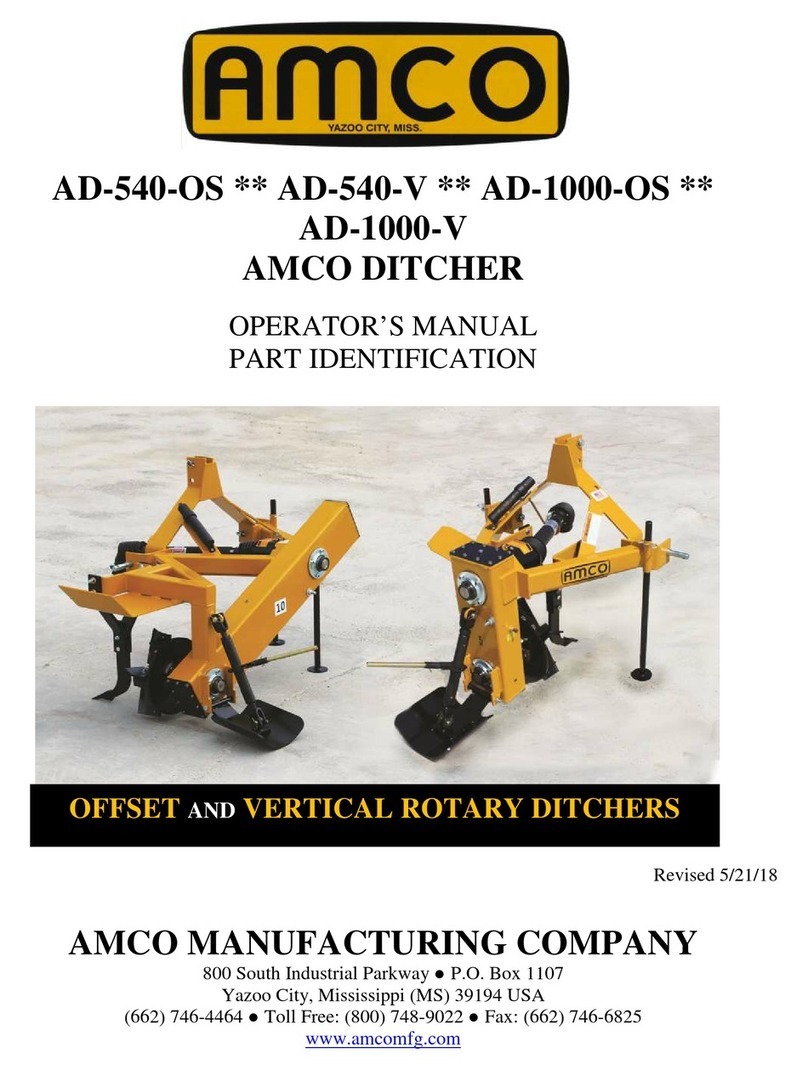
Amco
Amco AD-540-OS Operator's manual
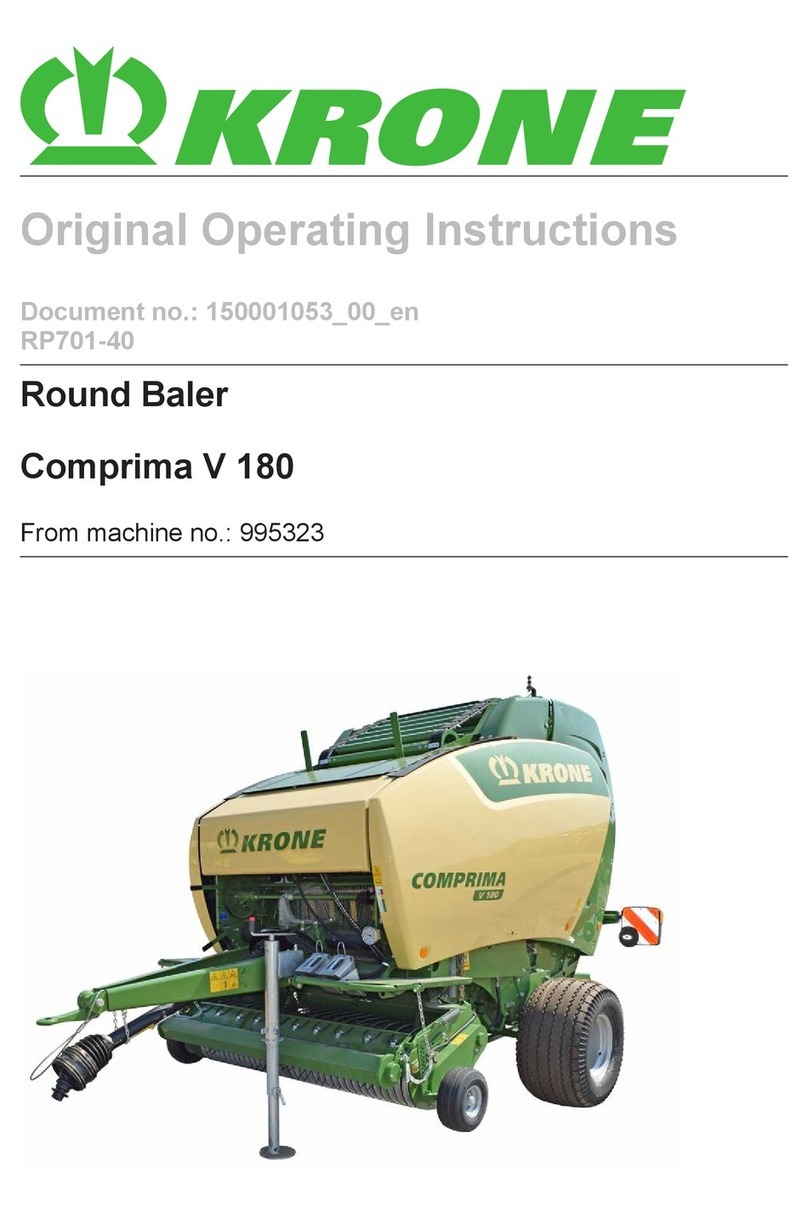
Krone
Krone Comprima V 180 Original operating instructions

Meridian
Meridian Harvest T1052 Operator's manual

Grizzly
Grizzly Field Boss Folding Wing manual
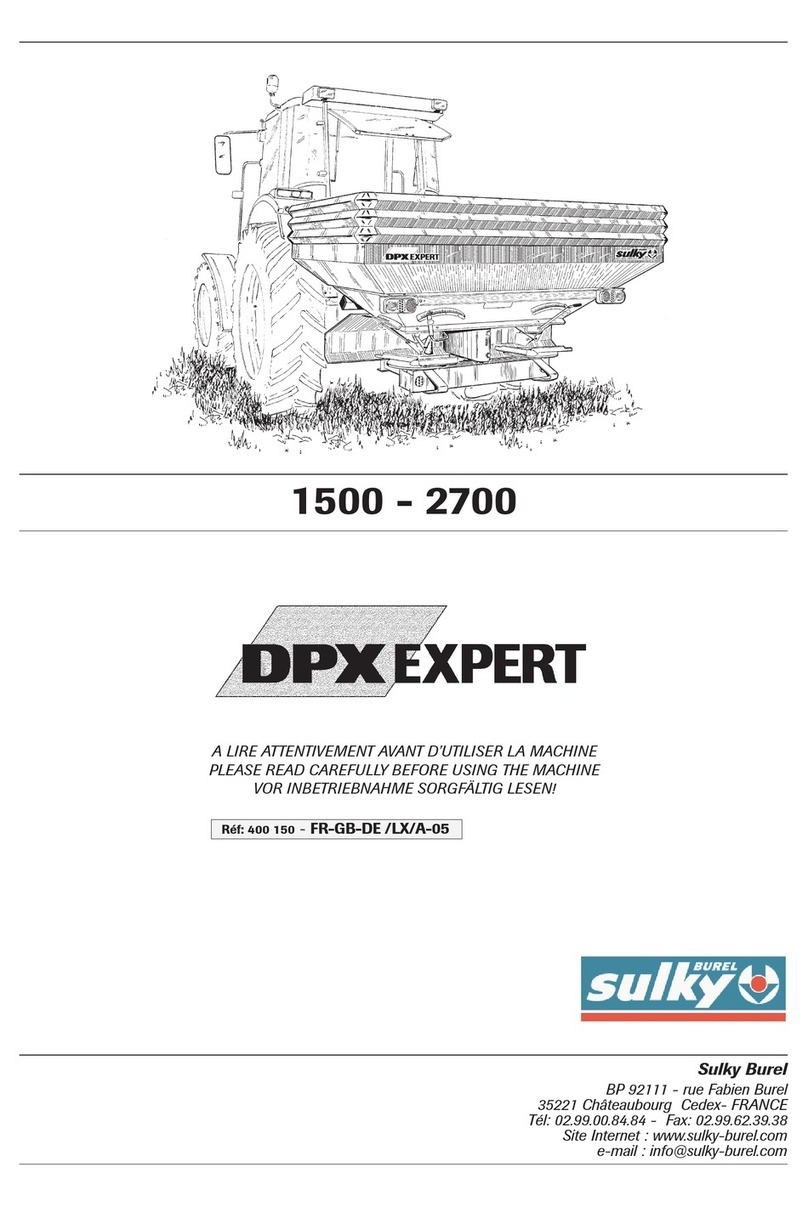
Sulky Burel
Sulky Burel DPX Expert Series manual
